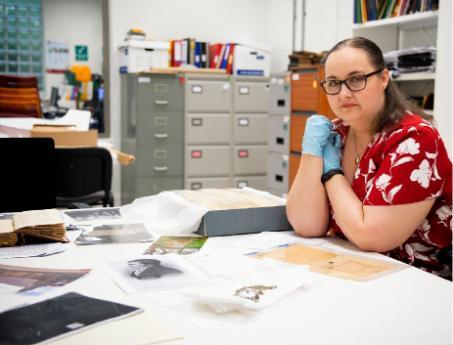September 2024: Re-imagining Robert Tannahill
Published: 1 September 2024
Re-imagining Robert Tannahill: a GMHN Early Career Foundation project
Re-imagining Robert Tannahill: a GMHN Early Career Foundation project

Dr Moira Hansen, The Open University
I suspect many of you reading this won’t know who Robert Tannahill was. To be honest, before this project, neither did I. I certainly didn’t know that in the 19th century, Tannahill’s popularity rivalled that of Robert Burns. Thousands of people gathered each year on the Gleniffer Estate near Paisley to celebrate this local-born weaver-poet. He has a statue outside Paisley Abbey and appears on Edinburgh’s Scott Monument. But now, 200 years later, while Burns’s memory continues to be celebrated annually, Tannahill seems to be all but forgotten.
So how did I get to be re-imagining someone I’d never heard of? It’s thanks to the team at Paisley Museum. As part of their multi-million-pound refurbishment, they want to bring Tannahill back into the public consciousness, taking a modern look at some of the centuries-old stories told about him. With the support of the Glasgow Medical Humanities Network Early Career Foundation award, I was able to apply the methods I’d developed to look at Robert Burns’s mental health to Tannahill. The Paisley team were interested in looking at the long-standing claims that Tannahill was affected by depression, culminating in him taking his own life by drowning at only 37 years old.
As will be reported in an article due to be published in Studies in Scottish Literature this autumn, there wasn’t enough material to convincingly assess whether Tannahill’s low moods reached the threshold for depression. But what we do see is Tannahill as someone who, to our modern eyes, didn’t seem sympathetic to those who were affected - in his mind, depression is something easily thrown off if one chooses to do so, and suicide is self-indulgent. This is set against sympathy for the family of the individual and the stigma that they would face. While Tannahill’s letters don’t give away too much in helping us understand his own moods, they do tell us a LOT about attitudes to mental health in the early nineteenth century.
Given the views that Tannahill expresses, it was striking to me that his own death was reported as a suicide. The accepted story is that Tannahill’s final weeks were marked by a descent into madness – confusion, hallucinations, wild eyes and profuse sweating – culminating in him drowning himself in Candren Burn, half a mile from his home, in the early hours of 17th May 1810. But maybe it’s not so clear cut. As reported recently in The Herald , marking the 250th anniversary of Tannahill’s birth, bringing a modern understanding to the circumstances raises another possibility. The reported symptoms may suggest a physical illness, perhaps some kind of infection which causes fever then, as it worsens, increasing confusion and erratic behaviour, including trying to cool off with a night-time dip.
It’s likely we’ll never know conclusively if Tannahill’s death was accidental or deliberate but, as with Tannahill’s letters, it adds to our understanding of nineteenth-century attitudes to mental health. With little to no distinction made between possible physical illness and genuine insanity, society perceived his death as a suicide, the press reported it as such, and his burial was handled as if it were so, Tannahill’s body being laid to rest outside the consecrated ground of the churchyard at the West Relief Church. As far as can be ascertained, no explanation other than suicide was ever considered.
Paisley Museum is due to reopen in 2025. Part of their exhibition space will feature a new display relating to Tannahill, including the pocket watch he carefully placed on the bank of the Candren Burn before he entered the water. Accompanying text will draw on the findings of my project, prompting the visiting public to think about how attitudes of the time shaped the way Tannahill’s story has been told, how our attitudes now can offer a new perspective and, in doing so, act as a marker of how far we have come (and still have to go) in addressing the stigma associated with poor mental health.
First published: 1 September 2024

